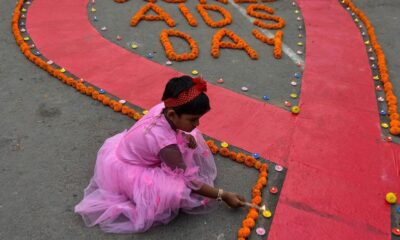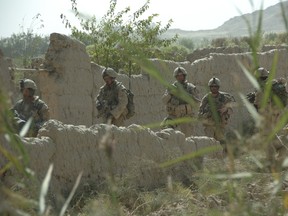World
Polio’s Resurgence: Challenges in Global Eradication Efforts

Polio, a disease once on the brink of eradication, is experiencing a resurgence primarily in Afghanistan and Pakistan. Over the past decade, Sughra Ayaz has dedicated her efforts to convincing parents in southeastern Pakistan to vaccinate their children against this paralytic disease. Despite her commitment, she encounters numerous barriers, including prevalent misinformation and families prioritizing basic needs like food and water over vaccinations.
Ayaz reports that some local managers have resorted to falsifying vaccination records to meet targets, undermining the integrity of the vaccination campaign. Compounding these issues, the vaccines require strict cold storage, which is not consistently maintained. “In many places, our work is not done with honesty,” Ayaz stated, highlighting the challenges faced by health workers on the ground.
Since the World Health Organization (WHO) and its partners launched the Global Polio Eradication Initiative (GPEI) in 1988, there have been significant achievements. However, the campaign has faced setbacks, particularly in the last two years. After reporting only five cases of wild polio in 2021, infections surged to 99 cases in 2022, prompting officials to miss multiple self-imposed eradication deadlines. Afghanistan and Pakistan remain the last countries where polio transmission has not been interrupted.
The GPEI has struggled with internal mismanagement and outdated strategies, according to various health workers and experts. Issues such as falsified vaccination records, untrained personnel administering vaccines, and a lack of field supervision have plagued the campaign. With over $20 billion invested, the GPEI has aimed to vaccinate billions of children, claiming substantial successes, including the prevention of paralysis in an estimated 20 million individuals.
Nevertheless, local staffers like Ayaz have repeatedly raised concerns about operational inefficiencies and the politicization of vaccination efforts. Dr. Jamal Ahmed, WHO’s polio director, defended the campaign’s achievements, asserting that many children are protected due to the extensive work carried out over the past four decades. He expressed optimism that polio transmission could be halted within the next 12 to 18 months, with an ultimate goal set for eradication by 2029.
The current vaccination targets set by the GPEI include about 45 million children in Pakistan and 11 million in Afghanistan for this year. Children typically require four doses of the oral vaccine to be considered fully immunized. Dr. Zulfiqar Bhutta, an advisor to WHO and other organizations, emphasized the need for campaign officials to heed criticism regarding their strategies. “Continuing blindly with the same strategies… is unlikely to lead to a different result,” he remarked.
Internal WHO documents reviewed by The Associated Press detail persistent issues in vaccination drives over the past decade. Reports indicate that local workers flagged significant problems to management as early as 2017, including instances of falsified records and improper vaccine administration. In one case, a team in Nawzad, Afghanistan, covered only half of its intended area during a campaign, missing 250 households entirely.
Cultural barriers further complicate vaccination efforts. Many health workers encounter resistance from families, often due to misconceptions about the vaccine. One anonymous worker noted that male relatives frequently prevent women from engaging in vaccination discussions. “Most of the time when we go to vaccinate and knock on the door, the head of the house or the man is not at home,” the worker explained.
A concerning practice known as “fake finger marking” has emerged, where health workers apply ink to indicate vaccination without actually administering the vaccine. Ayaz highlighted the immense pressure on field staff to produce results, often at the expense of genuine immunization efforts.
Polio predominantly spreads through contaminated water and can cause irreversible paralysis, particularly in children under five. Eradicating the disease requires achieving zero cases and immunizing over 95 percent of the population. Despite the oral vaccine’s proven safety and efficacy, concerns over its rare side effects have been raised. Some health experts argue that the oral vaccine should be replaced with an injectable variant that poses fewer risks, though logistical challenges hinder this transition.
The GPEI’s actions have drawn scrutiny, especially after a failed effort in 2016 that resulted in outbreaks in over 40 countries. The situation highlights the need for a comprehensive review of the initiative, as former WHO scientist Dr. T. Jacob John emphasized in his correspondence with WHO Director-General Tedros Adhanom Ghebreyesus.
With an annual budget of approximately $1 billion, the GPEI is among the most expensive public health campaigns. Recent geopolitical shifts have raised concerns about sustained funding, particularly following the withdrawal of U.S. support from WHO and cuts to foreign aid. Critics, including former WHO officials, argue for a reevaluation of funding allocation, suggesting that resources may be better spent addressing other pressing health needs.
In rural areas of Pakistan and Afghanistan, villagers have protested against the focus on polio vaccination, calling for more attention to basic health services. Many express confusion over the priority given to polio when other diseases like measles and tuberculosis require urgent intervention.
As misinformation continues to spread, particularly regarding the vaccine’s contents and effects, local health workers face an uphill battle. The legacy of past CIA operations, which involved a fake vaccination campaign to locate Osama bin Laden, has further eroded trust in vaccination efforts. Vaccine workers routinely confront this mistrust, complicating their mission to protect children from polio.
The resurgence of polio in Afghanistan and Pakistan underscores the complexities involved in eradicating the disease. As health workers like Sughra Ayaz navigate misinformation, logistical challenges, and cultural barriers, the urgent need for a reassessment of strategies and a renewed commitment to address local concerns becomes increasingly critical.
-

 Politics4 weeks ago
Politics4 weeks agoSecwepemc First Nation Seeks Aboriginal Title Over Kamloops Area
-

 World5 months ago
World5 months agoScientists Unearth Ancient Antarctic Ice to Unlock Climate Secrets
-

 Entertainment5 months ago
Entertainment5 months agoTrump and McCormick to Announce $70 Billion Energy Investments
-

 Science5 months ago
Science5 months agoFour Astronauts Return to Earth After International Space Station Mission
-

 Lifestyle5 months ago
Lifestyle5 months agoTransLink Launches Food Truck Program to Boost Revenue in Vancouver
-

 Technology3 months ago
Technology3 months agoApple Notes Enhances Functionality with Markdown Support in macOS 26
-

 Lifestyle3 months ago
Lifestyle3 months agoManitoba’s Burger Champion Shines Again Amid Dining Innovations
-

 Top Stories2 months ago
Top Stories2 months agoUrgent Update: Fatal Crash on Highway 99 Claims Life of Pitt Meadows Man
-

 Politics4 months ago
Politics4 months agoUkrainian Tennis Star Elina Svitolina Faces Death Threats Online
-

 Sports5 months ago
Sports5 months agoSearch Underway for Missing Hunter Amid Hokkaido Bear Emergency
-

 Politics5 months ago
Politics5 months agoCarney Engages First Nations Leaders at Development Law Summit
-

 Technology5 months ago
Technology5 months agoFrosthaven Launches Early Access on July 31, 2025





















